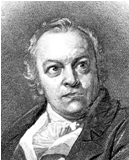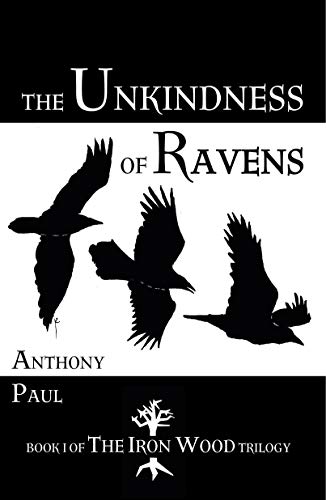Songs of Innocence and Experience by William Blake
Page 6 of 18 - 1 2 3 4 5 6 7 8 9 10 11 12 13 14 15 16 17 18 Purchase full notes for £5.95 (aprox $9.28)
The experienced world is under darkness and the stars, and this couple perhaps wish to linger on the ‘darkening green.’ Old John is central to the second plate, and represents the same strong paternal, protective presence as the central oak of the first illustration.
Blake’s song is full of the sounds of joy, which are imagined ‘Ecchoing’ about the green: ‘bells,’ ‘sky-lark,’ ‘thrush,’ as well as the implied racket of the ‘sports.’ The poem’s sound-play also underlines this theme. The first line concludes with a powerfully stressed iamb (‘arise’), which chimes with the next line’s rhyme (‘skies’) and sets up a strong rising tone throughout the first stanza, so that it is possible to imagine the poem itself creating an echo.
The next stanza emphasises the community aspect of innocence. The ‘old folk’ cannot share in the games of the young, but witnessing this innocence allows them to ‘laugh away’ the cares of experience. Young and old are united, and the old remember and value their youth (though there may be a sense of experienced adults dismissing the value of play in the line ‘They laugh at our play’).
The ending of the day has suggested the verge of experience for many readers (‘the darkening green’), but this should not necessarily be seen negatively. This stanza, in fact, mainly emphasises archetypal images of family security (‘like birds in their nest’), all of which align with the innocent world. The innocent children must go to their cosy beds and turn their backs on the ‘darkening green’ where new and adult ‘sports’ may soon be seen. It is also important that the children are allowed to play for as long as possible (cf. Nurse’s Song ) as Blake supported a liberal and positive attitude to children and play.
Laughing Song
It is a temptation with Blake to skate over the surface of these apparently ‘simple songs’. The temptation with ‘Laughing Song’ is particularly strong. There is, however, more than meets the eye.
The illustration, for a start is of grown men and women, while most of Blake’s illustrations for innocence focus on children. These are young adults, drinking wine in a rural setting (is that the oak’s canopy again in the background?) and laughing their heads off: something Blake is celebrating as a fundamental element of the world of innocence (cf. the child laughing in ‘Introduction’ and Old John in ‘The Ecchoing Green’). As Keith Sagar notes, laughing was not always seen so positively in Blake’s time: ‘Not long before Blake, the Wesley brothers, founders of Methodism, had taught that laughter, singing - other than hymns - and dancing were sinful and should be eradicated in schools.’
Blake’s song is full of the sounds of joy, which are imagined ‘Ecchoing’ about the green: ‘bells,’ ‘sky-lark,’ ‘thrush,’ as well as the implied racket of the ‘sports.’ The poem’s sound-play also underlines this theme. The first line concludes with a powerfully stressed iamb (‘arise’), which chimes with the next line’s rhyme (‘skies’) and sets up a strong rising tone throughout the first stanza, so that it is possible to imagine the poem itself creating an echo.
The next stanza emphasises the community aspect of innocence. The ‘old folk’ cannot share in the games of the young, but witnessing this innocence allows them to ‘laugh away’ the cares of experience. Young and old are united, and the old remember and value their youth (though there may be a sense of experienced adults dismissing the value of play in the line ‘They laugh at our play’).
The ending of the day has suggested the verge of experience for many readers (‘the darkening green’), but this should not necessarily be seen negatively. This stanza, in fact, mainly emphasises archetypal images of family security (‘like birds in their nest’), all of which align with the innocent world. The innocent children must go to their cosy beds and turn their backs on the ‘darkening green’ where new and adult ‘sports’ may soon be seen. It is also important that the children are allowed to play for as long as possible (cf. Nurse’s Song ) as Blake supported a liberal and positive attitude to children and play.
Laughing Song
It is a temptation with Blake to skate over the surface of these apparently ‘simple songs’. The temptation with ‘Laughing Song’ is particularly strong. There is, however, more than meets the eye.
The illustration, for a start is of grown men and women, while most of Blake’s illustrations for innocence focus on children. These are young adults, drinking wine in a rural setting (is that the oak’s canopy again in the background?) and laughing their heads off: something Blake is celebrating as a fundamental element of the world of innocence (cf. the child laughing in ‘Introduction’ and Old John in ‘The Ecchoing Green’). As Keith Sagar notes, laughing was not always seen so positively in Blake’s time: ‘Not long before Blake, the Wesley brothers, founders of Methodism, had taught that laughter, singing - other than hymns - and dancing were sinful and should be eradicated in schools.’

